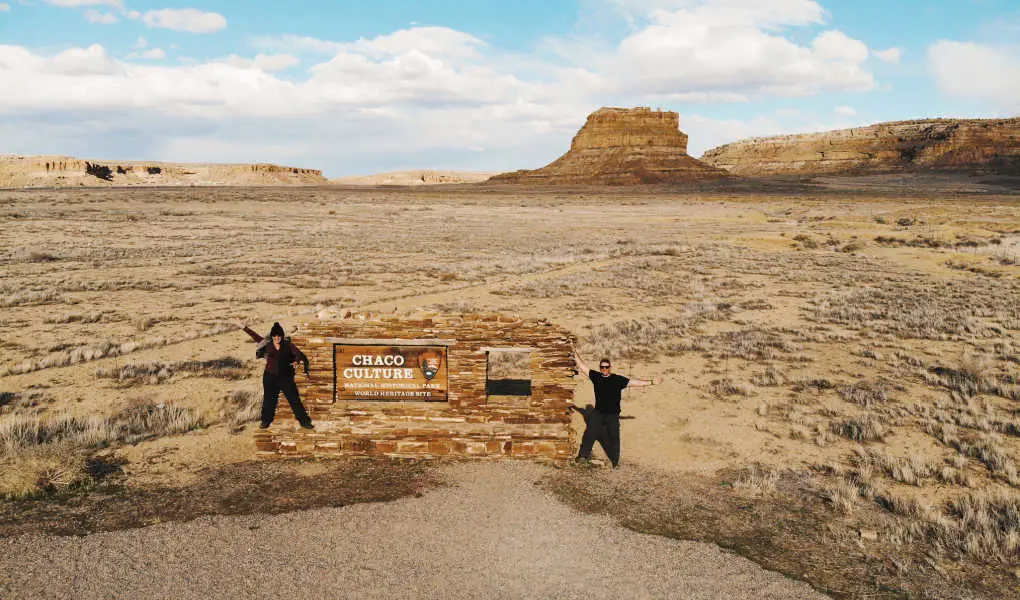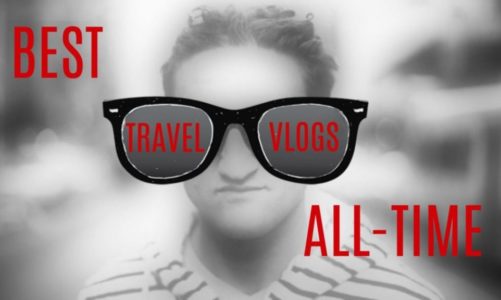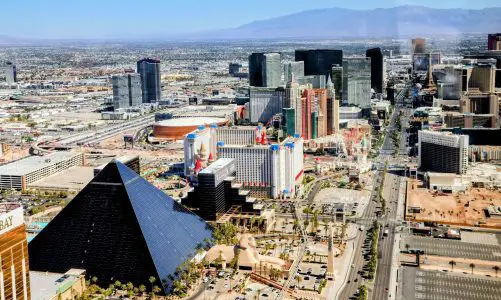Chaco Culture National Historical Park or Chaco Canyon is America’s token archaeological site, comparable to Egypt’s pyramids or Peru’s Machu Picchu. The national park contains an interesting collection of ancient ruins that date back over 1,000 years.
The focal point for most visitors of Chaco Canyon is Pueblo Bonito, the largest prehistoric Southwest Native American dwelling ever excavated. However, the biggest thrill and highlight of the day during our visit was taking the Pueblo Alto Trail up the side of a cliff to gain an aerial perspective of Pueblo Bonito. Don’t worry, you’ll be fine as long as you’re not claustrophobic or scared of heights—kidding!
Brief History of Chaco Culture National Historical Park
After walking through the dry barren landscape it may be hard to believe that about 1,000 years ago Chaco Canyon was a lively bustling city. Its inhabitants were the Anasazi (“Ancient Ones”), ancestors of the modern Pueblo Indians (Rio Grande Pueblo, Hopi, Zuni, etc.).
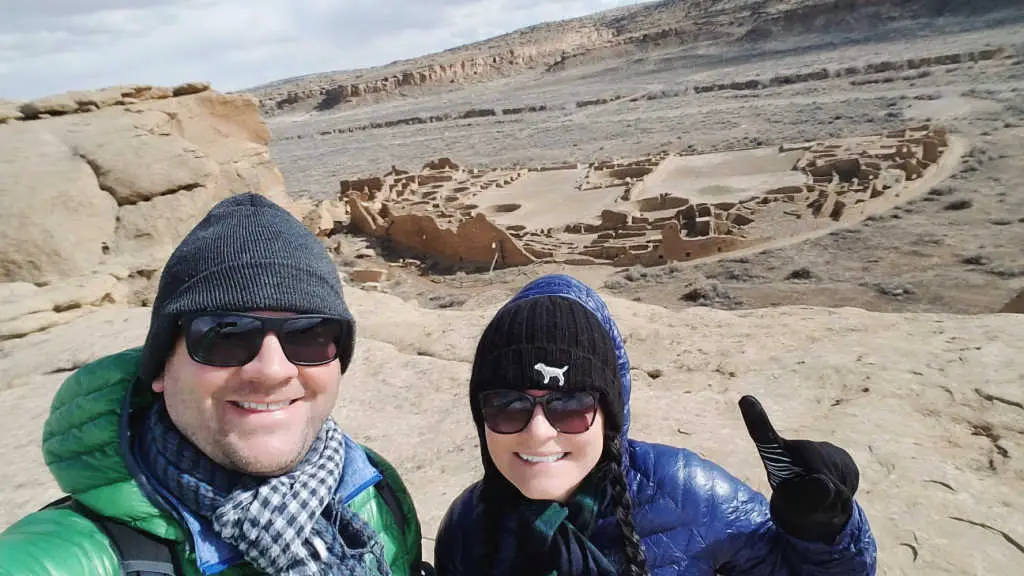
The Anasazi are believed to have lived in the Four Corners area as far back as 1500 B.C. Furthermore, from about A.D. 200 to A.D. 1300, the Anasazi built many significant settlements in the area including in Navajo National Monument, Mesa Verde National Park, and Chaco Canyon.
From cliff-sited dwellings and small pit houses to massive grand houses, the Anasazi lived in a wide variety of structures. What makes Chaco Culture National Historical Park so special is that it was constructed during the peak of cultural and societal development. In terms of historical significance and uniqueness, Chaco is oftentimes compared to the ancient city of Rome, Egypt’s pyramids, or Stonehenge.
Chacoan Society
The Anasazi who lived in Chaco Canyon are now referred to as Chacoans. Furthermore, their society flourished from A.D. 1000–1150. Chacoans built 16 major complexes made from tabular sandstone slabs, clay mortar, and timber imported from distant mountain areas.
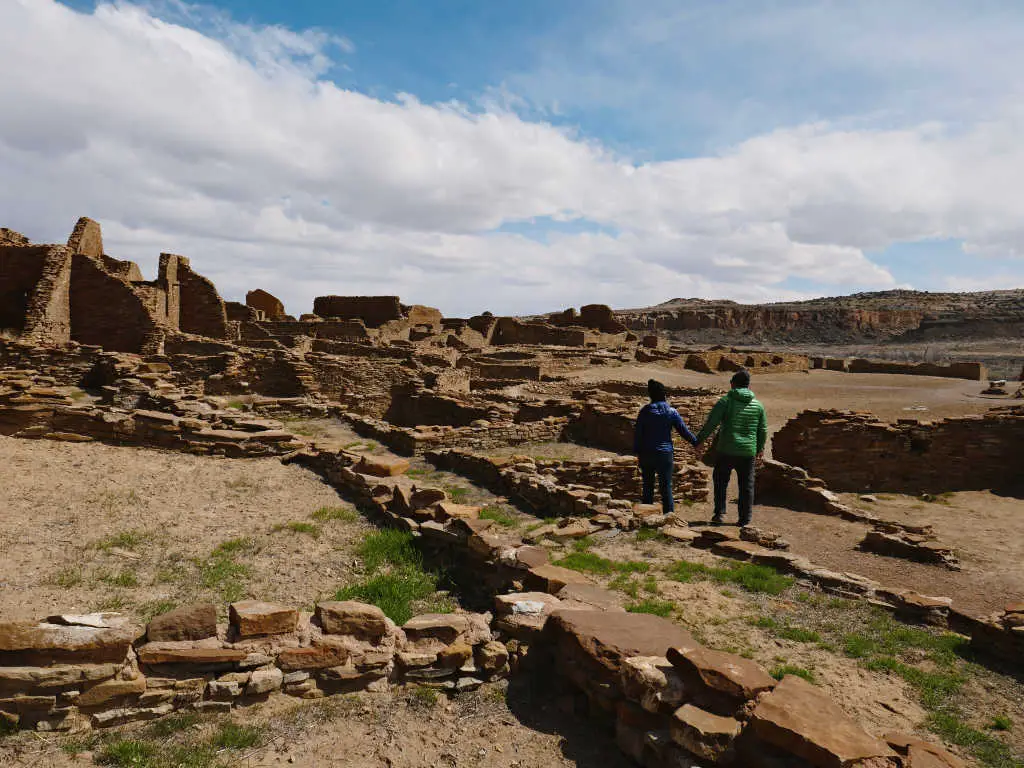
Referred to as a great house, Pueblo Bonito was a massive building that had three-foot-thick walls and stood nearly 50 feet high. The impressive masonry architecture attracted other tribal members. Thus, Chaco quickly became the epicenter for the Anasazi people, serving as the most significant hub for trade, ceremony, and administration. These Chacoan complexes are the largest buildings constructed in North America before the 19th century.
Beyond their engineering achievements, they constructed intricate astronomical elements which enabled them to accurately track equinoxes, solstices, lunar standstill, and measure time. As a result, Chacoans had the ability to anticipate the movements of planets, stars, the moon, and the sun.
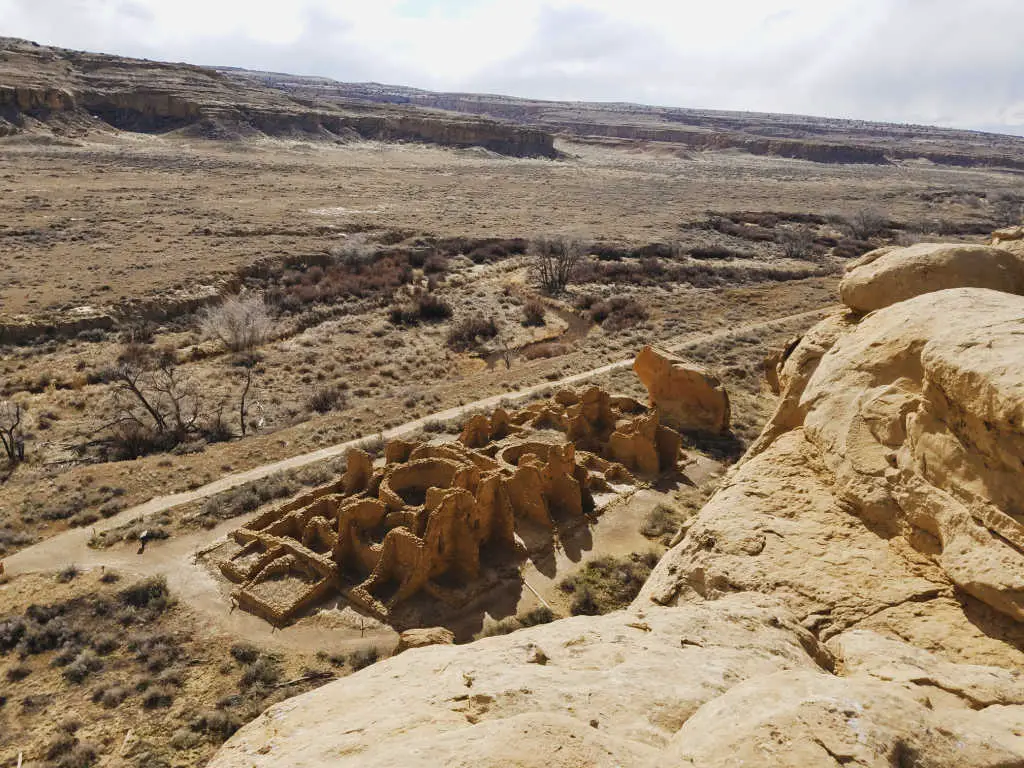
Many visitors to Chaco Culture National Historical Park leave absolutely astonished by the magnitude of the constructed buildings. Others depart impressed, never knowing about the cultural and engineering feats that took place in North America before the arrival of Europeans. If the history of Chaco piques your interest, you may be interested in reading The Chaco Meridian or House of Rain: Tracking a Vanished Civilization Across the American Southwest before visiting the park.
Where to Stay Near Chaco Canyon
We visited Chaco Culture National Historical Park during our journey down Route 66. Also, the closest lodging options from the south, along Route 66 are in Gallup and Grants, approximately 90 miles away. While, the closest options overall are from the north in Bloomfield, approximately 60 miles from the park.
Chaco Canyon is remote. In fact, many people think that the park would be one of the nation’s most popular if it wasn’t so hard to reach. For example, the last 20 miles to the park (coming from the south) take place on a washboard dirt road.
Even when regarding all of the obstacles, the park is still very much worth visiting. Moreover, below are the best places to stay near Chaco Canyon.
Grants/Gallup (Route 66/I-40)
Budget: Comfort Suites (comfortable)
Mid Range: El Rancho Hotel (historic Route 66 hotel-this is where we stayed!)
Luxury: Fairfield Inn & Suites (pool & hot tub)
Bloomfield/Farmington (US Hwy 64)
Budget: Super 8 by Wyndham (great staff)
Mid Range: Best Western Plus Territorial Inn & Suites (pool & hot tub)
Luxury: Home2 Suites (fitness center & pool)
Finally, camping is possible at Chaco Culture National Historical Park. Specifically, at Gallo Campground, just east of the visitor center, sites are available for RVs, tents, and car camping.
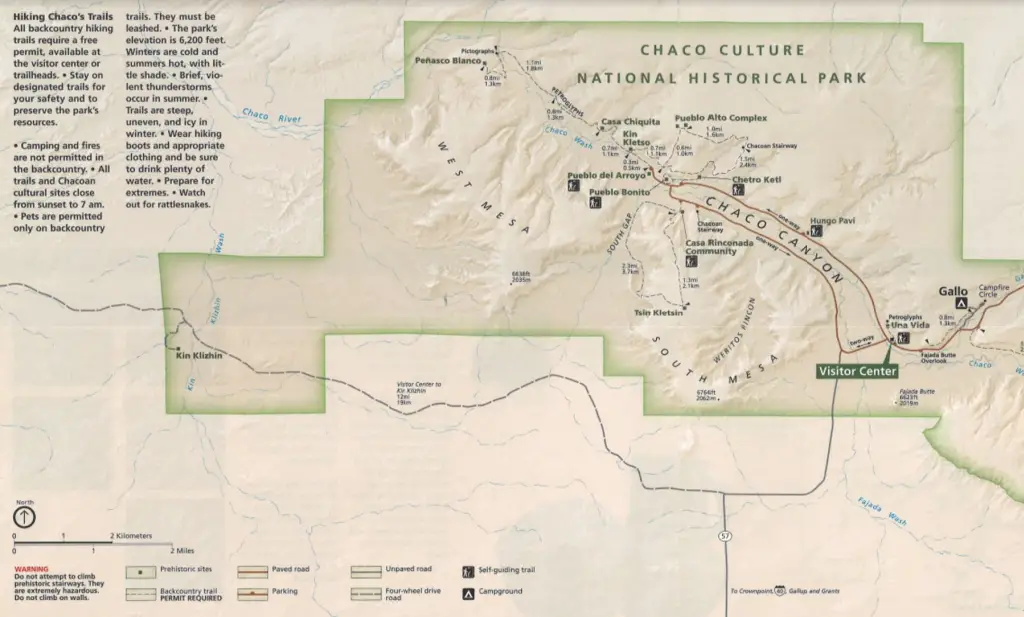
7 Must-do Things To Do at Chaco Canyon
Chaco Culture National Historical Park’s remote location makes it a great place to enjoy history, nature, solitude, and night skies. For these reasons, Chaco Canyon is an ideal place for hiking, cycling, and camping.
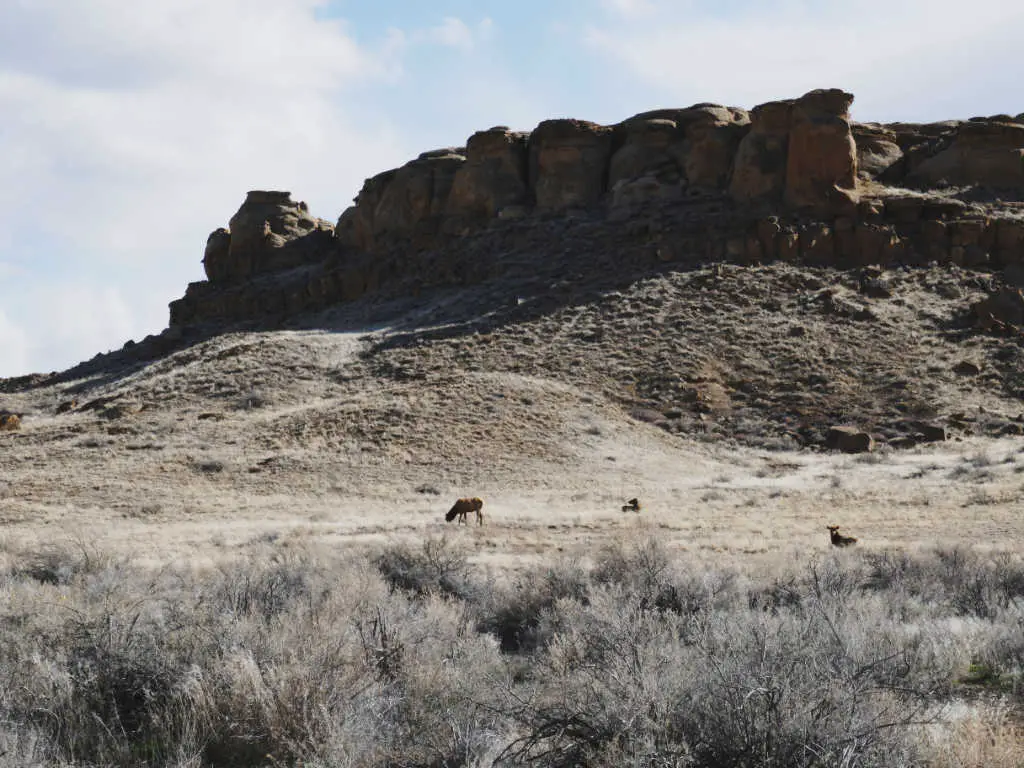
However, for most first-time visitors, the highlight of visiting Chaco is simply exploring the ancient ruins.
SEVEN MUST-DO THINGS AT CHACO CANYON
Select a must-do thing or scroll down to view all.
1. Pueblo Bonito
2. Chetro Ketl
3. Petroglyph Trail
4. Pueblo del Arroyo
5. Casa Rinconada
6. Hungo Pavi
7. Una Vida & Petroglyphs in Fajada Gap
Below are seven amazing things to see at Chaco Culture National Historical Park.
1. Pueblo Bonito
Pueblo Bonito is the most important, most celebrated, and scrupulously investigated site in Chaco Culture National Historical Park. Early Spanish explorers named the massive great house Pueblo Bonito because it resembled a ‘pretty village.’ As a result, Pueblo Bonito is considered a must-see and a highlight of the canyon.
Guests may tour the remains of Chaco’s largest great house on a 0.6-mile walking trail. To begin with, construction on Pueblo Bonito began in about AD 850 and lasted for about 300 years. Upon completion, the massive complex covered three acres, was five stories high, and had about 800 rooms.
Pueblo Bonito was the center of the Chacoan world and was constructed in the shape of a semicircle. The central plaza features numerous kivas. These were semi-subterranean circular rooms that archaeologists believe were used for religious, political, and economic ceremonies. Moreover, great kivas are significantly larger than standard kivas and used for only the most important ceremonies.
Features of a Chacoan great kiva include four seating pits for roof supports, niches in the wall, a bench around the circumference, two vaults on either side, and a raised firebox in the center. Lastly, rectangular rooms were used for housing and storage surrounding the plaza.
Pueblo Bonito Overlook
Plan on spending about one hour exploring the ruins. Afterward, enjoy an amazing view of the great house on the Pueblo Alto Trail. The trailhead starts near the Pueblo del Arroyo parking lot and proceeds behind Kin Kletso or “yellow house.”
The short 2.0-mile hike was the highlight of our trip to Chaco Culture National Historical Park. Hikers must walk up an unexpectedly steep and narrow crevasse to get to the top of the cliff.
Upon ascension, the remaining 0.7 miles to the scenic overlook is fairly flat. Plan on taking at least one hour to complete the walk. Don’t forget to leave a permit (which is in a box near the trailhead) on the dashboard of your vehicle.
2. Chetro Ketl
Chetro Ketl is the second-largest great house and is located just before Pueblo Bonito along the 9-mile Canyon Loop Drive. With about 400 rooms, the D-shaped structure is believed to have been used as a place for large-scale ceremonies.
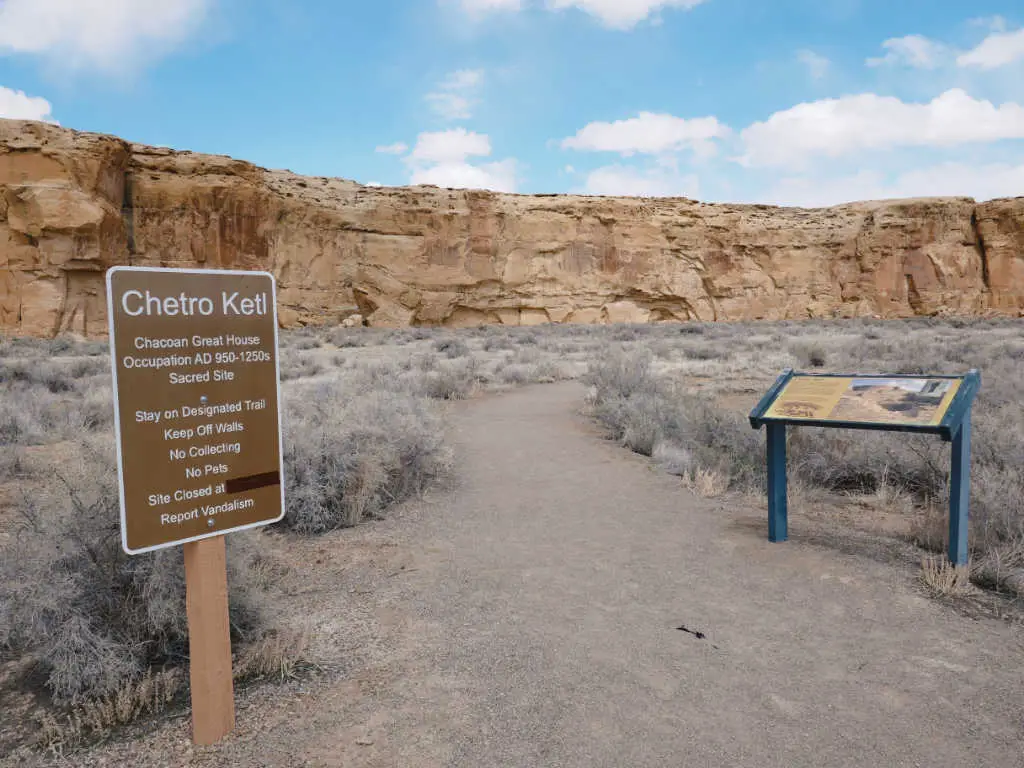
It’s estimated that it took 50 million sandstone slabs and 26,000 trees to erect Chetro Ketl over some 500,000 man-hours. At nearly 3 acres, Chetro Ketl is considered the largest great house by area in Chaco Culture National Historical Park.
A 0.5-mile trail guides visitors through the ruins of Chetro Ketl. Highlights of the tour include a well-preserved great kiva, elevated kivas, and several hundred feet of intact perimeter wall. Plan on allowing a half-hour to tour Chetro Ketl.
3. Petroglyph Trail
After touring Chetro Ketl make sure to check out the Petroglyph Trail. A short trail runs along the cliff face between Chetro Ketl and Pueblo Bonito and features various petroglyphs.
As you walk along the trail, make sure to look both high and low as petroglyphs are scattered throughout the cliff face. Archaeologists assume that the higher petroglyphs were created by standing on roofs or using ladders. Holes in the wall indicate that some sort of heavy beams may have been used to anchor the building into the cliff.
Due to the size and elevation of the petroglyphs, bringing travel-sized binoculars or a quality zoom camera is recommended. Allow about 20 minutes to complete the 0.3-mile Petroglyph Trail.
4. Pueblo del Arroyo
Pueblo del Arroyo is the last major stop along the 9-mile Canyon Loop Drive road. Believed to have had about 300 rooms and 17 kivas, the D-shaped great house’s name means “village by the wash.”
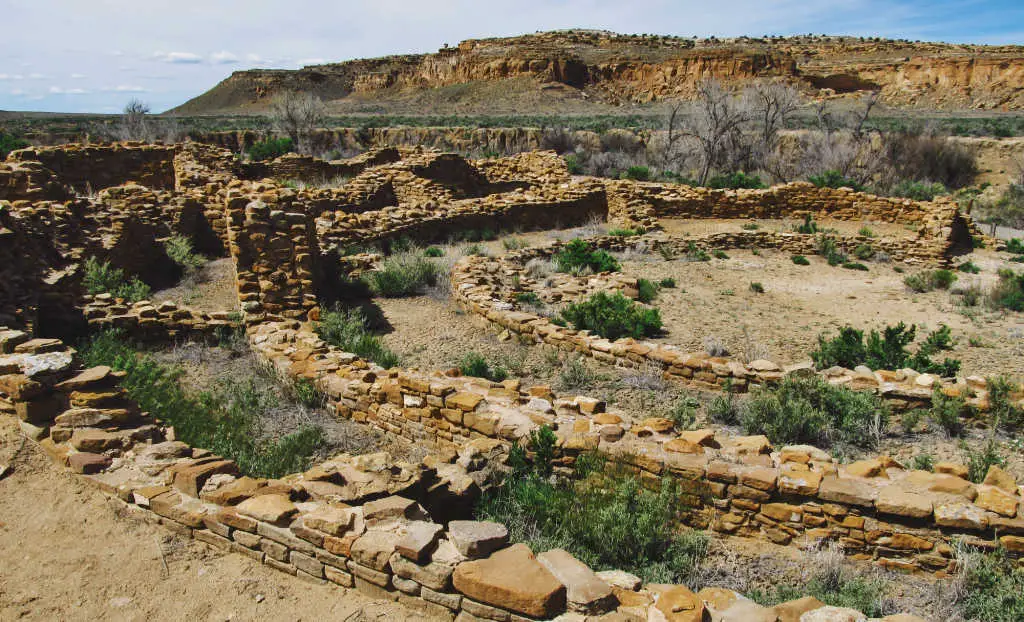
As the fourth largest great house in Chaco, Pueblo del Arroyo is unique in that it’s the only great house not constructed along the cliff face. Also, it’s the only one facing east, instead of south. Archaeologists believe it was constructed to account for overcrowding at Pueblo Bonito.
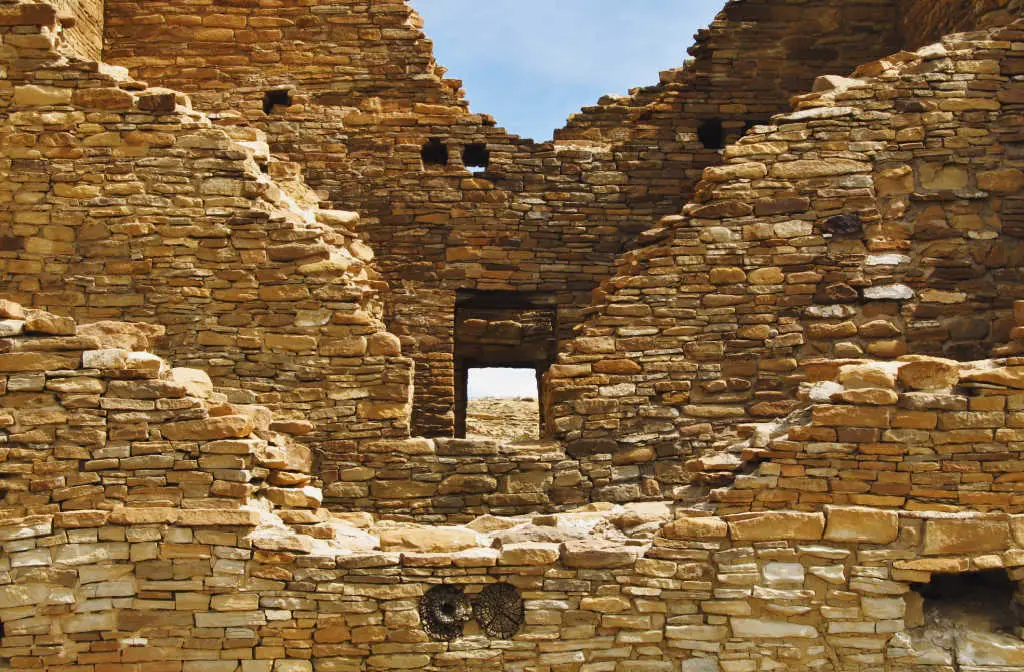
Highlights of Pueblo del Arroyo include a rare triple-walled structure that is believed to have been used for ceremonial purposes, keyhole-shaped kivas, and well-intact walls. Due to accessibility to the parking lot, plan on allowing about 20-30 minutes to tour Pueblo del Arroyo.
5. Casa Rinconada
Not being embedded within a large complex make Casa Rinconada a particularly special great kiva. Instead, it stands alone on the top of a small hill.
With a diameter of about 70 feet, Casa Rinconada is one of the largest known great kivas. Also, unlike the typical great kiva where the roof is at ground level, Casa Rinconada is partly above ground.
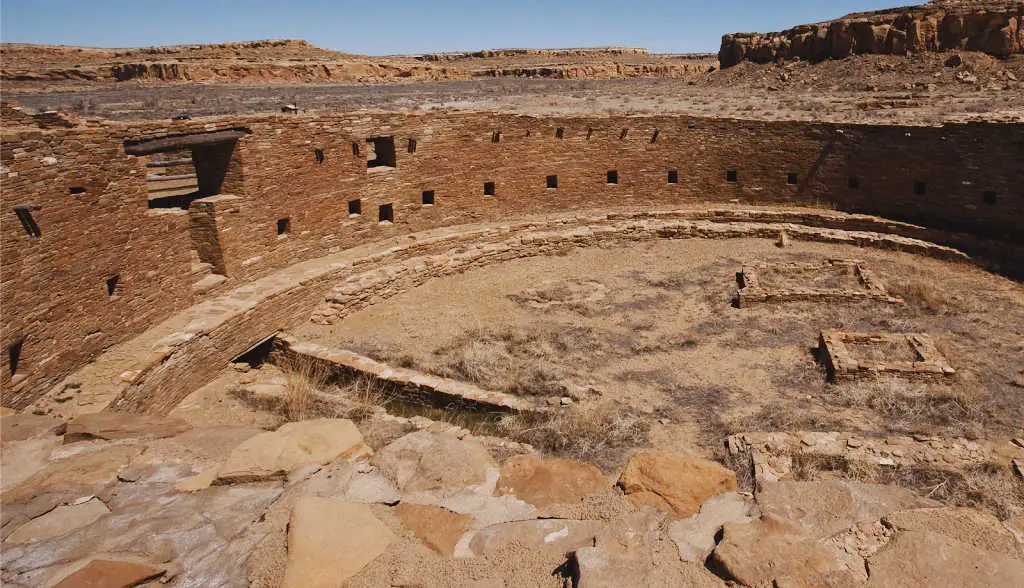
Two other interesting aspects of Casa Rinconada include the two T-shaped entrances on a south-north alignment and a subterranean passageway. This “secret” passageway would have allowed officiants to enter and exit the kiva by bypassing the entranceways.
The trail to Casa Rinconada is 0.5 miles long and traverses through a small Chacoan village. Consequently, walkers may view a wide variety of Chacoan buildings and architectural styles. Allow about 45 minutes to tour Casa Rinconada.
6. Hungo Pavi
Hungo Pavi is one of the first major stops upon departing the visitor center. While unexcavated, it’s still an impressive great house to tour in Chaco Culture National Historical Park and provides a glimpse of what these structures looked like before excavations.
The ruins contain an enclosed plaza, a great kiva, and about 140 rooms. Also, the great house is likely to have been three stories tall and D-shaped. Allow about 15-20 minutes to tour Hungo Pavi.
7. Una Vida & Petroglyphs in Fajada Gap
The visitor center is the first stop for most guests to Chaco Culture National Historical Park. Visitors may purchase souvenirs including travel guides for each of the sites inside. Directly behind the center is a one-mile roundtrip trail to Una Vida that features several petroglyphs.
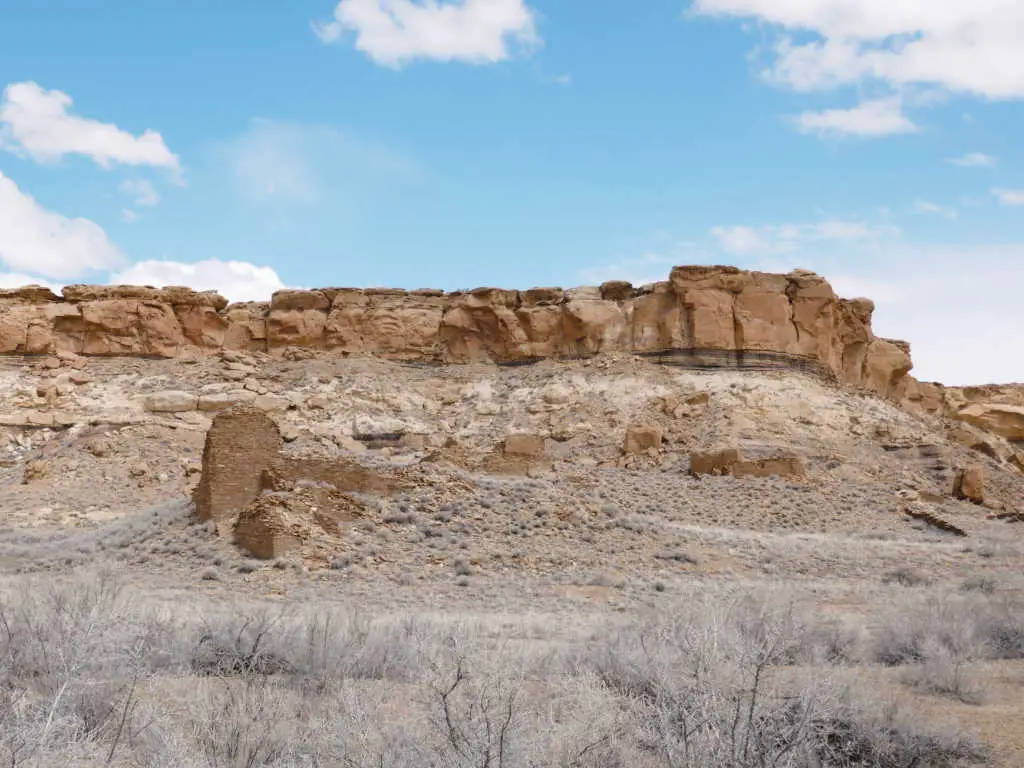
Una Vida and the visitor center are located in the Fajad Gap. One of the most prominent features that can be viewed along the trail is the Fajada Butte, which makes the landscape seem out of this world.
Along with Pueblo Bonito, Una Vida is one of the oldest great houses and with about 160 rooms, the fifth largest. The largely unexcavated site is in the shape of an irregular D and contains four kivas and one or two great kivas. Allow for between 45 minutes to 1 hour to complete the walk.
8. Bonus: Fajada Butte
Probably the most famous natural feature of Chaco Canyon is Fajada Butte. In fact, for most visitors, it’s the first thing that catches their eye when entering the park.
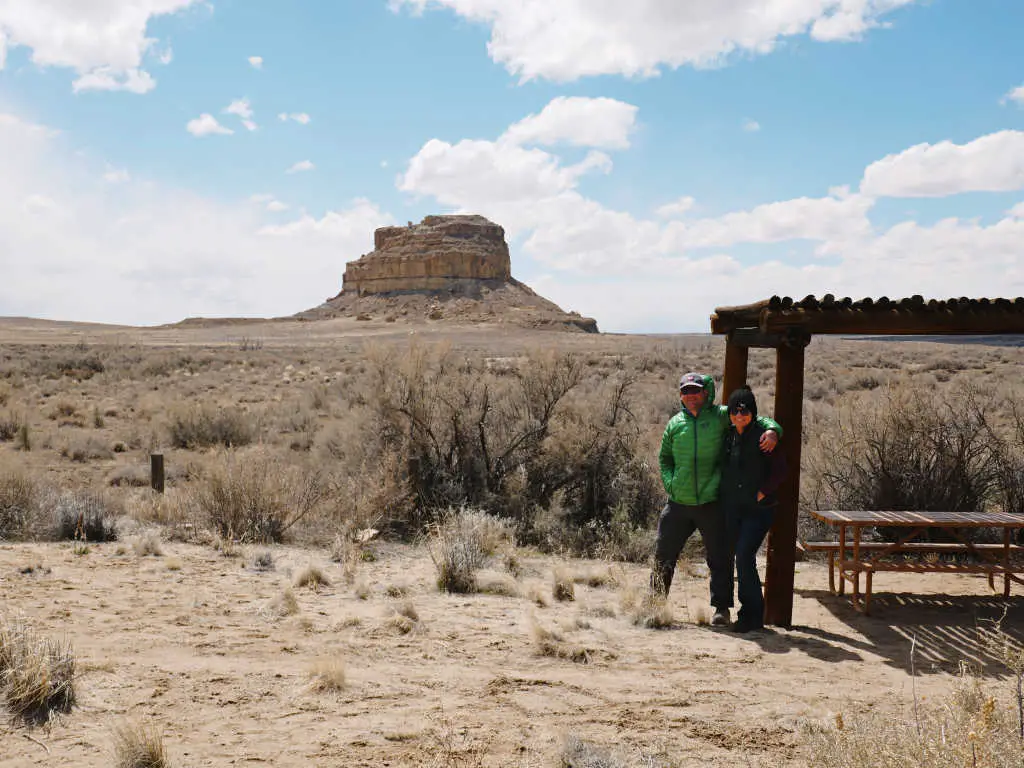
Visitors are not allowed on or really even near the isolated hill for several reasons including the fact that local tribes consider it a sacred place, there is no maintained trail to reach the top, and its fragility. Also, there is a set of spiral petroglyphs known as the “Sun Dagger” that make this location one of the most special in the park.
Chacoans had a sophisticated knowledge of the planetary system and used the Sun Dagger site to integrate the spiritual and physical worlds, set ceremonial calendars, and plan agriculture. More specifically, Chacoans used the spiral petroglyphs to record the day of solstices, and equinoxes, and track the 18.6-year lunar cycle.
Sadly, due to shifting rock slabs and erosion the Sun Dagger site no longer works as it once did. Therefore, it’s best to enjoy it from a distance!
Below is the map for the Pueblo Alto Trail in Chaco Canyon.
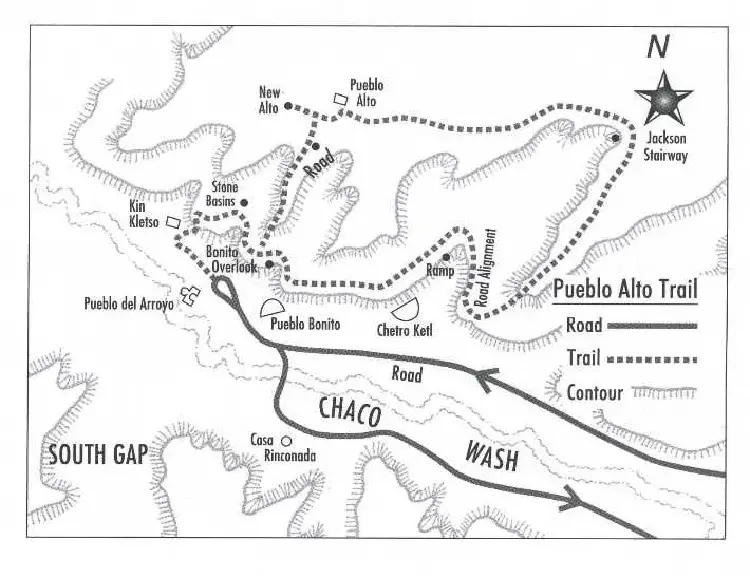
We Need Your Help
Did you find this article helpful? If so, bookmark it and when you’re planning your next vacation, click on any of the links below before finalizing reservations. You’ll get the best price, we’ll earn a small commission, and you’ll help support future articles.
Thank you!
BEST TRAVEL SEARCH ENGINES
🏘️ Book Accommodation
We use Tripadvisor to compare prices and reviews in advance and check availability
✈️ Book Your Flight
To find the cheapest flight options, use Skyscanner to find the most suitable choice for you
🚗 Reserve Rental Car
Use Discover Cars to compare prices and view the largest selection of vehicles

